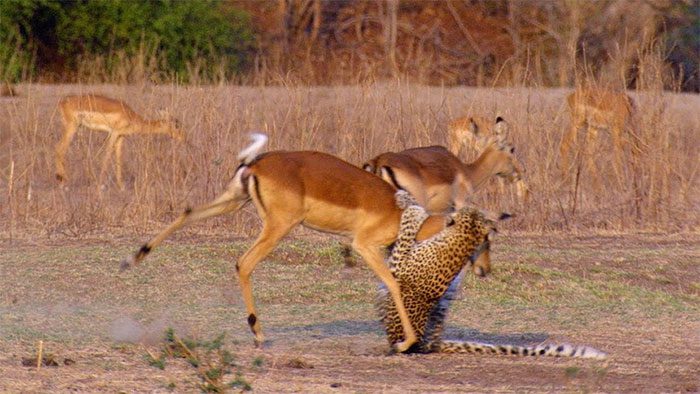The hunter may be skilled, but the prey can be even more remarkable.
Much like a microcosm of society, the wild has its own order established by powerful hunters. These are the most fearsome predators in nature, positioned at the top of the food chain, as categorized by scientists.
Among carnivorous species, perhaps the big cats are the most captivating predators, exhibiting both grace and strength. Scientists refer to this group as the Panthera family, which includes lions, leopards, jaguars, and tigers. This is one of the most formidable families in the wild, possessing staggering statistics such as a lion’s success rate of 30%, a cheetah’s 58%, a leopard’s 38%, and a tiger’s 5%.

Leopard attacking an Impala.
Among these, the leopard is the most versatile with a nearly comprehensive skill set for running, climbing, and swimming. These attributes seem like a compensation from Mother Nature for their relatively smaller size compared to their relatives. They typically have a modest body length of about 2 meters and weigh between 30 to 90 kg when fully grown.
Leopards possess a specialized body structure, well-suited for incredible bursts of speed. According to scientists, these animals can reach maximum speeds of up to 120 km/h, with a stride length of up to 8 meters when sprinting, and they can achieve a speed of 95 km/h in just four strides.
Additionally, leopards have excellent vision with a field of view exceeding 200 degrees, allowing them to easily gauge distances to their prey and detect any lurking dangers. However, their eyesight is poor at night, which leads them to hunt primarily during the day, even in the bright midday sun.
Thanks to these advantages, leopards have become one of the most successful predators in Africa.
Their diet mainly consists of wildebeests, buffaloes, zebras, and various other antelope species in the African savannah. However, fierce competition from other predators, including their relatives, and a significant decline in animal populations due to environmental changes have made hunting increasingly challenging for leopards. Not to mention the unexpected incidents that can occur during a hunt, much like the clip below.
The video presents a scene set in the African savannah, where a dry creek bed surrounded by weeds is depicted. It is easy to see that this is a resting and feeding spot for a herd of impalas and some baboons. The peaceful setting has lulled the herbivores into a false sense of security, unaware of a leopard stealthily approaching the creek. Viewers are captivated by the leopard’s masterful camouflage, as nearly all creatures nearby remain oblivious to the presence of this apex predator. It is only when the predator launches its attack that it becomes too late.
The leopard’s strength and speed are vividly showcased in each frame. Naturally, its prey is captured in the blink of an eye. The impala is swiftly dragged into the depths of the pit. However, nature often holds surprises. In a twist that seems almost magical, from the depths of the dark pit, the impala suddenly rises and leaps back to the surface. The breathtaking spectacle, coupled with the astonishing agility of the unfortunate prey, leaves the audience in awe and admiration.


















































